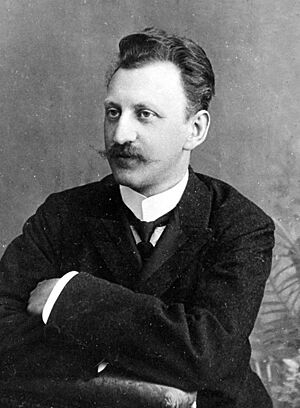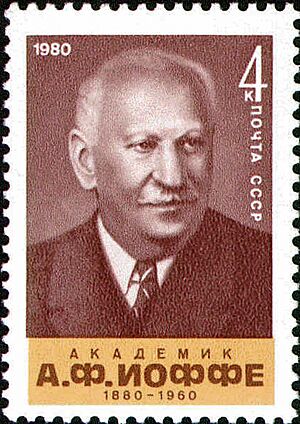Abram Ioffe facts for kids
Quick facts for kids
Abram Ioffe
|
|
|---|---|
 |
|
| Born |
Abram Fedorovich Ioffe
29 October 1880 Romny, Poltava Governorate, Russian Empire (now Ukraine)
|
| Died | 14 October 1960 (aged 79) |
| Alma mater | Munich University (PhD 1905); Saint Petersburg State Institute of Technology (1902) |
| Awards | Lenin Prize (1961) 3×Order of Lenin |
| Scientific career | |
| Fields | Physics |
| Institutions | State Institute of Roentgenology and Radiology; Leningrad Physico-Technical Institute |
| Doctoral advisor | Wilhelm Röntgen |
| Doctoral students | Nikolay Semyonov Pyotr Lukirsky Pyotr Kapitsa |
| Signature | |
Abram Fedorovich Ioffe (Russian: Абра́м Фёдорович Ио́ффе; 29 October 1880 – 14 October 1960) was a very important physicist from the Soviet Union. He won several major awards for his work. These included the Stalin Prize in 1942 and the Lenin Prize in 1960. He was also named a Hero of Socialist Labor in 1955.
Ioffe was an expert in many areas of physics. He focused on how materials behave, especially in solid state physics. He also studied electromagnetism, which is about electricity and magnetism. He created many research labs for new discoveries. These labs studied things like radioactivity, superconductivity, and nuclear physics. Many of these labs later became famous independent institutes.
Contents
Discovering Abram Ioffe's Life
Abram Ioffe was born in 1880 in a small town called Romny. This town was in the Russian Empire, which is now part of Ukraine. His family was a middle-class Ukrainian Jewish family.
Early Education and Mentorship
After finishing his studies at the Saint Petersburg State Institute of Technology in 1902, Ioffe traveled to Munich. For two years, he worked as an assistant to a famous scientist named Wilhelm Röntgen. Röntgen was the person who discovered X-rays.
Ioffe earned his Ph.D. (a high-level university degree) from Munich University in 1905. His main research was about how electricity moves through special crystals. He studied how these crystals react to electrical pressure.
Career and Key Discoveries
After 1906, Ioffe started working in Saint Petersburg, Russia. This city was later renamed Leningrad. He worked at the Polytechnical Institute and eventually became a professor there.
In 1911, Ioffe made a very important discovery. He figured out the exact charge of an electron. Electrons are tiny particles that carry electricity. He did this experiment on his own, at the same time as another scientist named Robert Andrews Millikan.
For his experiment, Ioffe used tiny zinc particles. He shined ultraviolet light on them to make them release electrons. Then, he used an electric field to balance these charged particles against gravity. This allowed him to measure their electrical charge. He published his findings in 1913.
In 1918, he became the head of the Physics and Technology section. This was at the State Institute of Roentgenology and Radiology. This section later became the Leningrad Physico-Technical Institute (LPTI) in 1917. Today, it is known as the Ioffe Institute.
Contributions to Radar Technology
In the early 1930s, the military needed a way to find enemy aircraft. Many research groups worked on "radio-location" techniques. This is what we now call radar.
In January 1934, the Russian Academy of Sciences held a meeting. They wanted to see how far this technology had come. Ioffe organized this important conference. He then wrote a report that shared this new science with researchers around the world. This helped develop modern radar systems.
Later Career and Legacy
When the Soviet atomic bomb project started in 1942, Ioffe was asked to lead it. However, he felt he was too old for such a big task. Instead, he suggested a younger scientist named Igor Kurchatov. Ioffe believed Kurchatov had great potential. He put Kurchatov in charge of the first nuclear laboratory.
Later, in 1950, Ioffe had to leave his director position at LPTI. He also left the board of directors. This was due to political changes happening in the country at that time.
From 1952 to 1954, he led a lab that studied semiconductors. These are special materials used in electronics. This lab later became the Institute of Semiconductors.
After Ioffe passed away in 1960, the LPTI was renamed the Ioffe Physico-Technical Institute. It is still one of Russia's most important research centers today.
Many famous scientists were students of Abram Ioffe. These include Pyotr Kapitsa, Igor Kurchatov, Nikolay Semyonov, and Léon Theremin. Ioffe even helped Pyotr Kapitsa get a spot at the famous Cavendish Laboratory in England.
Commemoration
- The lunar crater Ioffe on the Moon is named after him.
- The Ioffe Physico-Technical Institute carries his name.
- A Russian research ship, the Akademik Ioffe, is named after him.
- The asteroid 5222 Ioffe is named in his honor.
Patents
- U.S. Patent 1,807,292 "Translating device"
- U.S. Patent on the piezoelectric effect


